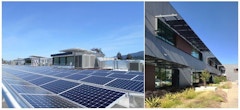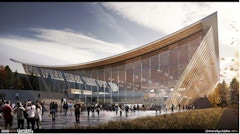
11 results
-
 The historical focus on reducing the carbon footprint of a building has recently shifted to include more emphasis on embodied carbon, the carbon…
The historical focus on reducing the carbon footprint of a building has recently shifted to include more emphasis on embodied carbon, the carbon… -

Sustainable Silicone
- Paper by Jon Kimberlain · Adrienne Bowman-Grittini · Stanley Yee
Silicone materials have a long history in high performance building projects. Known for durability, they can reduce a building’s carbon footprint by
-

Highly Efficient Façades with Innovative Shading and Light Control
- Paper by Klaus Reuschle, Project Director Robert Matthew Noblett, Partner Michelle Siu-Ching Lee, Roman Schieber, Associate Director ppa.
The Science and Engineering Complex (SEC) on the Allston Campus is the largest new building at Harvard University in recent decades with a footprint… -
Xilinx Case Study
- Paper by Michael Martinez, LEED AP · Stet Sanborn, AIA, LEED AP, CPHC
The transformation of a dark and inhumane 1970s tilt-up concrete office building into a high performance, light-filled modern workplace was enabled
-

Modern Heritage and Facade Improvements
- Paper by Uta Pottgiesser, Angel Ayón,
Approximately 80% of our total building stock is from the 20th century. During the last decades, along with an increasing appreciation of modern… -

Infinite Panel System
- Paper by Mike Ryan, Director of Product Development Facades Division Brian Stern, Regional Energy Director Michael Adams, Senior Energy Analyst
Today, building facades are expected to do much more than merely provide shelter, which is driving the need for higher performing envelope solutions.… -
Hybrid Timber
- Paper by Stacey Hooper, AIA, LEED BD+C
This case study provides an overview of building hybrid curtain wall system and future opportunities for the use of timber. It will also review the
-
Carbon-Neutral High-Rise Envelope Nexus
- Paper by Thomas Spiegelhalter
The pathway to carbon-neutrality, as urged during the COP 21 in Paris, and the repeated goal for resilient buildings and urban habitats, winds right
-

Façade Systems and Embodied Carbon
- Paper by Paulina Szpiech, Associate - Facade Engineering Valerie Leon-Green, Facade Engineer Shivanie Rambaran, Graduate Energy Analyst
Life Cycle Assessment (LCA) is a methodology used to quantify the impact of building construction supply chains on the environment in terms of… -

Preserving a Historic Facade
- Paper by Maria Mohammed, S.E. · John Fidler, RIBA, Intl Assoc AIA, FRICS, FSA, FRSA, FIIC, FAPT
Environmental and socio-economic benefits of sustainable preservation have become apparent most recently in the restoration of the historic former
-
Generative Design Tool
- Paper by Amir Hosseinzadeh Zarrabi · Mona Azarbayjani · Maryam Tavakoli
The piezoelectric facade as a self-sustained technology can generate a considerable amount of energy by converting swaying motions (actuated by the


